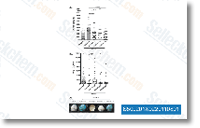Right here we describe a third peptide from your library display that has a distinct mechanism of action. The data presented right here recommend that peptide 5nd, can be a partially random cysteine modifier that inhibits RGS4 as a result of disulfide bond formation among the peptide along with the RGS. Success and discussion We not long ago described a bead primarily based display in which 2. five ? 106 numerous peptide sequences were ready as a OBOC library, Fluorescently labeled RGS4 was applied to probe the library for peptides that bind RGS4, A total of 14 peptide sequences had been obtained and, in our to begin with report, 1 peptide sequence selleck was observed to inhibit RGS4 stimulated GTPase action. Because the vast majority of those hit peptides could bind tightly on the RGS not having disrupting GAP activity, they have been also tested while in the movement cytometry protein interaction assay, which measures the interaction concerning RGS4 and G o.
On this technique we applied a Luminex movement cytom eter to detect the binding of Alexa Fluor 532 labeled G o to biotinylated RGS4 on avidin beads in the presence of AMF to put the G subunit right into a transition state like conformation, Peptides have been tested at 50 M except exactly where limited by solubility, Fourteen peptide sequences obtained through the OBOC display, in the two acetylated, disulfide bridged or absolutely free N terminal disulfide Dihydroartemisinin bridged versions, have been tested and five showed statistically sig nificant inhibition of your RGS4 G o interaction in the FCPIA assay, Peptide five was by far the most lively, 5nd inhibited G o binding to a variety of distinctive RGS proteins, The IC50 values are 28 M, 43 M, 66 M, 145 M and 175 M for RGS4, RGS8, RGS16, RGS19 and RGS7, respectively, By far the most potent effects had been on RGS4, RGS8 and RGS16, which all belong towards the same RGS relatives and share the best sequence homology.
RGS19 and RGS7 are during the RZ and R7 households, respectively and present significantly less inhibition by 5nd. Linear as well as bridged versions of peptide five have been examined while in the FCPIA since cyclization yields would most likely have already been significantly less then 100% inside the syn thesis within the library leaving some linear peptides current on every single bead. The free N terminal linear  and acetylated linear peptides have been uncovered for being inactive, This may perhaps be thanks to lack of struc tural rigidity required for the right interaction in the peptide using the RGS protein or even a purpose for chemical reac tivity of your disulfide. We subsequent needed to determine the mechanism of action of peptide five. A modest molecule inhibitor of RGS4, methyl N 4 nitrobenzenesulfinimi doate was identified in a FCPIA screen and located to interact with RGS4 by cysteine modifica tion, We needed to determine if peptide 5nd acts in a similar method. When biotin RGS4 on avidin beads was treated with 5nd, fol lowed by washing of your beads, the inhibition of RGS4 G o interactions was not reversed, Inclusion of dithiothreitol from the wash buffer appreciably decreased 5nd action, These information recommend the peptide may bind irreversibly through a disulfide bridge.
and acetylated linear peptides have been uncovered for being inactive, This may perhaps be thanks to lack of struc tural rigidity required for the right interaction in the peptide using the RGS protein or even a purpose for chemical reac tivity of your disulfide. We subsequent needed to determine the mechanism of action of peptide five. A modest molecule inhibitor of RGS4, methyl N 4 nitrobenzenesulfinimi doate was identified in a FCPIA screen and located to interact with RGS4 by cysteine modifica tion, We needed to determine if peptide 5nd acts in a similar method. When biotin RGS4 on avidin beads was treated with 5nd, fol lowed by washing of your beads, the inhibition of RGS4 G o interactions was not reversed, Inclusion of dithiothreitol from the wash buffer appreciably decreased 5nd action, These information recommend the peptide may bind irreversibly through a disulfide bridge.
Phosphorylase Signal
Phosphorylase kinase is a 1.3 MDa hexadecameric holoenzyme.
